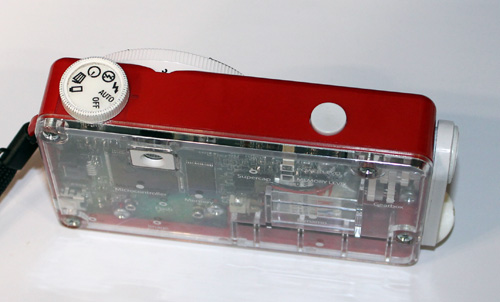It’s a big leap from Lego and Meccano that’s for sure… It used to be all about the latest set, with vast complicated moving structures and delicate vehicles that would keep boys and girls fixated for hours. Now, it appears a new generation of build-yourself toys has arrived. Lego and Meccano might have spawned some of the countries architects and engineers but the Bigshot promises to be different. It’s the world’s first complex toy camera, and retails at $89 (£58). But will it birth the next generation of photographers?
The creator, Professor Shree Nayar certainly hopes so. He believes that children will learn the basics of computing, by first being able to assemble the camera, and then acquire a working knowledge of the camera by sharing the photos that they capture. Its premise is great, and in an age steadily becoming dominated by computer tech, it seems to be an obvious step for a product of its kind.
All of you that built lego houses will still be able to outline the basic features for structural integrity. Much the same is expected of the Bigshot from its creator, but he is taking it a lot further…
…“It’s about getting kids’ hands dirty.”
“In an age when software rules I want kids to know how to build hardware.”
“We describe concepts that children would normally encounter at college, but try to make them accessible even to an 8 or 10 year old.”
As you can imagine, this has been a truly impressive undertaking and if it pays off he will have successfully enabled degree level concepts to be taught to pre-teens!
Currently the camera has only been launched in the US, with an aim to spread sales to the whole of North America. It was originally developed in 2006 in the computer science department at Columbia University, New York, headed by Professor Nayar. Following this, he sent out prototypes to children in India, Japan, Vietnam and the US and then used their feedback to tweak the design.
This coupled with funding from Google and the US Department of Defence enabled him to develop the kit. Eventually professor Nayar plans to use part of the cash generated from sales to send the cameras to children around the world who could not afford them.

Building and Features
Buyers of the Bigshot’ device will need to assemble the camera from its parts in a specific sequence to ensure it will work. Along with this, an online guide will explain the science behind each component and how it connects with others to enable the camera to function. This seems to be where a large amount of the project has focused. Putting explanations into a format which will allow children to understand the complicated concepts of electronics, image processing and display technology are far from easy.
The camera will come with a hand crank that enables the beholder to take pictures well after the battery runs out. Just crank up and snap; an ingenious decision for children who probably won’t have the patients to charge the device, as well as being a green one. The camera will come with a rotating wheel with three different lenses so they can choose between 3D, regular and panoramic shots.

Competition and Success
This is not the only toy-style camera on the market. Companies like Vtech, Fisher Price and Vivitar – offer cheaper cameras that are very child friendly. Some of these beat the Bigshot’s 3 megapixel resolution, but then I’m not sure that is going to affect its popularity and Nayer believes that Bigshot offers something different.
It might provide a great learning experience but as a camera I think it is lacking marketability in the west. After all, from the age of 5 almost one in ten children in Britain have a mobile phone and half will be fairly computer literate by 8-10 years old providing they have access to one. Most phones these days have a camera of some-sort. So the Bigshot could possibly be aimed at an even younger audience.
Even though the concept is brilliant, its launch comes at a time when the sales of digital compact cameras are declining, which could provide some worry for Bigshot. Despite this I believe that this product could fill a gap in the market for curious youngsters with a passion for photography. Wouldn’t it be great if it inspires a new generation of photographers?
Featured images:
License: Image author owned
License: Image author owned
License: Image author owned
Sam is an aspiring writer with an interest in all things digital. He has recently taken up photography as a hobby and has been learning the ins and outs of photography. Currently he is blogging for lenslocker.co.uk.





